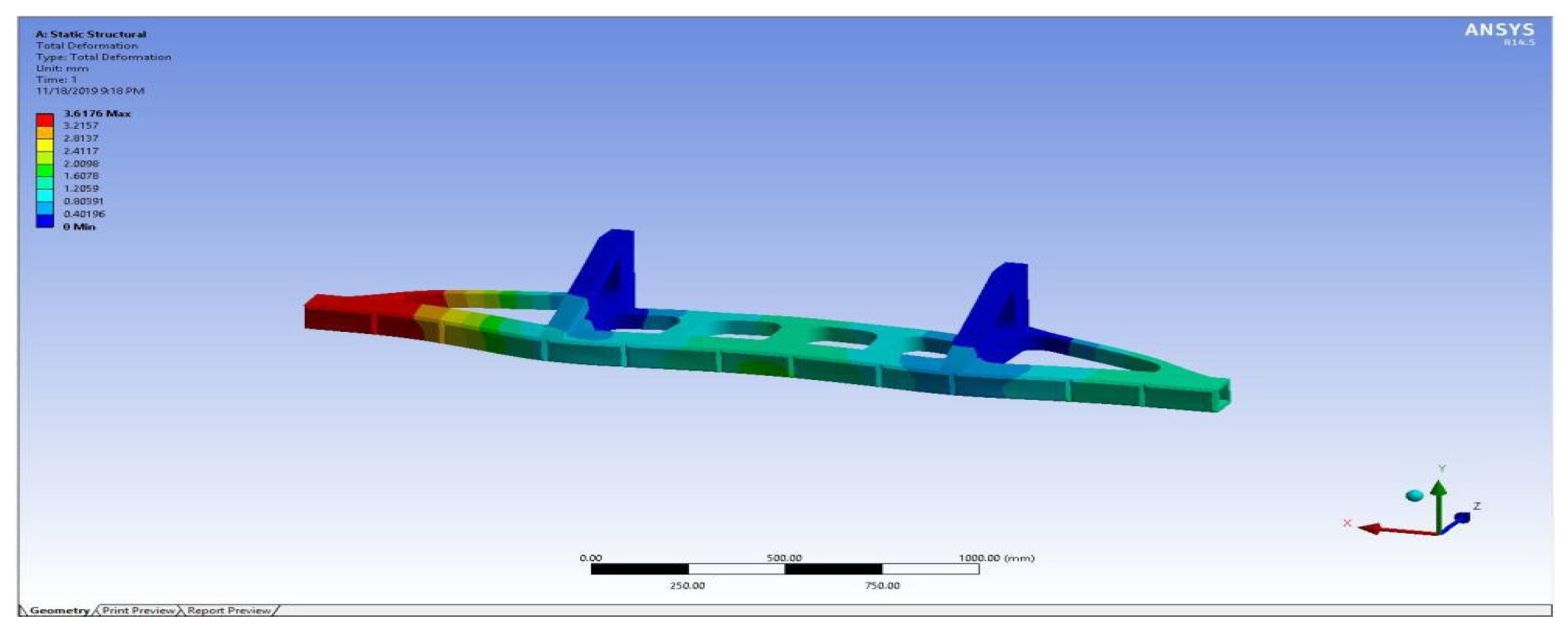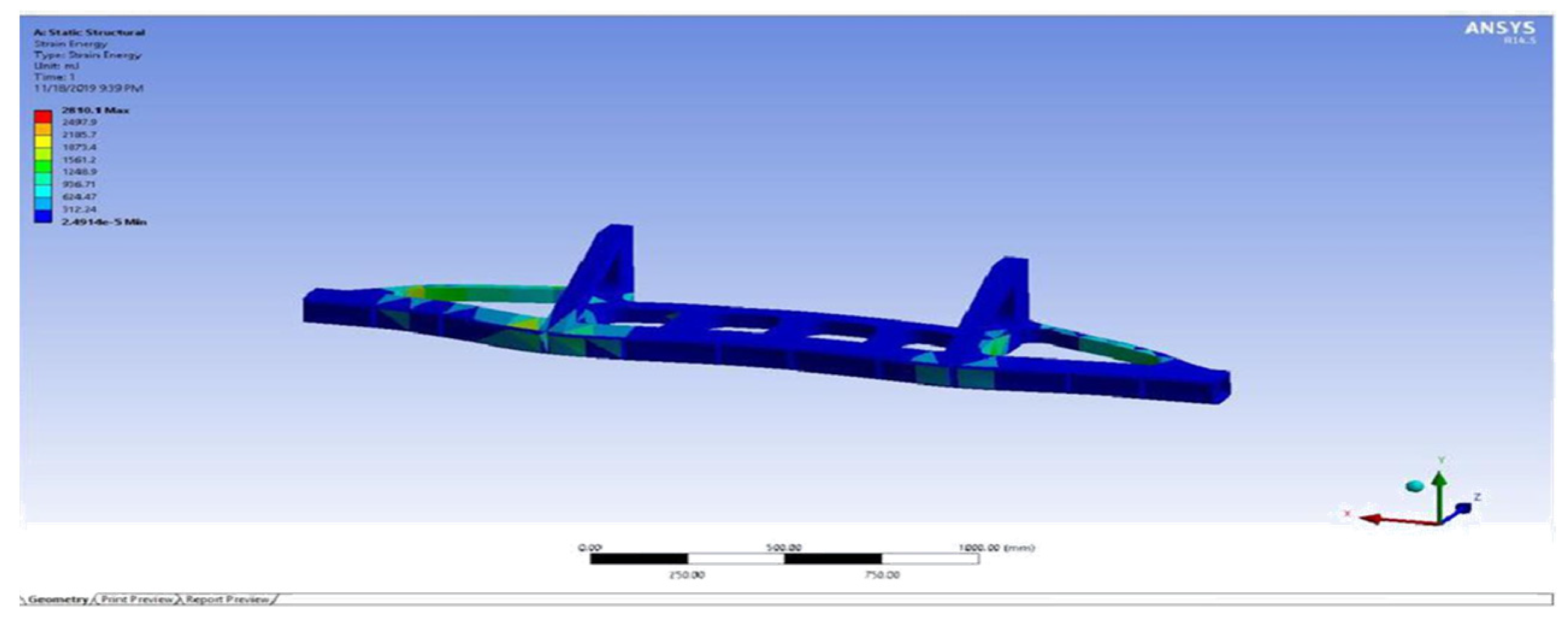An Investigation into the Design and Analysis of the Front Frame Bumper with Dynamic Load Impact †
Abstract
1. Introduction
2. Design, Modelling, and Meshing
3. Result and Discussion
4. Conclusions
Author Contributions
Funding
Institutional Review Board Statement
Informed Consent Statement
Data Availability Statement
Conflicts of Interest
References
- Baker, B.C.; Nolan, J.M.; O’Neill, B.; Genetos, A.P. Crash Compatibility between Cars and Light Trucks: Benefits of Lowering Front-End Energy-Absorbing Structure in SUVs and Pickups. Accid. Anal. Prev. 2008, 40, 116–125. [Google Scholar] [CrossRef] [PubMed]
- Davoodi, M.M.; Sapuan, S.M.; Aidy, A.; Osman, N.A.A.; Oshkour, A.A.; Abas, W.A.B.W. Development Process of New Bumper Beam for Passenger Car: A Review. Mater. Des. 2012, 40, 304–313. [Google Scholar] [CrossRef]
- Marzbanrad, J.; Alijanpour, M.; Kiasat, M.S. Design and Analysis of an Automotive Bumper Beam in Low-Speed Frontal Crashes. Thin-Walled Struct. 2009, 47, 902–911. [Google Scholar] [CrossRef]
- Rajan, B.G.; Padmanabhan, S.; Ganesh, R.L.; Chandana, K.M.; Lavanya, E. Low Velocity Impact Analysis of Carbon/Glass/Epoxy Hybrid Composite Pipes. Mater. Today Proc. 2021, 47, 4181–4188. [Google Scholar] [CrossRef]
- Basith, M.A.; Reddy, N.C.; Uppalapati, S.; Jani, S.P. Crash Analysis of a Passenger Car Bumper Assembly to Improve Design for Impact Test. Mater. Today Proc. 2021, 45, 1684–1690. [Google Scholar] [CrossRef]
- Sonawane, C.R.; Shelar, A.L. Strength Enhancement of Car Front Bumper for Slow Speed Impact by FEA Method as per IIHS Regulation. J. Inst. Eng. Ser. C 2018, 99, 599–606. [Google Scholar] [CrossRef][Green Version]
- Tuljapure, S.B. Design of Bumpers of Light Commercial Vehicles for Effective Energy Absorption during the Frontal Impact. Ph.D. Thesis, Solapur University, Kondi, India, 2016. [Google Scholar]
- Liu, W. Computer-Aided Design AutoCAD Is Widely Used in 3D Modeling. In Application of Intelligent Systems in Multi-Modal Information Analytics: 2021 International Conference on Multi-Modal Information Analytics (MMIA 2021), Volume 2; Springer: Cham, Switzerland, 2021; pp. 373–380. [Google Scholar]





| Stainless Steel | Al Alloy | E-Glass | |
|---|---|---|---|
| Total deformation, mm | 0.07699 | 3.2157 | 0.028772 |
| Von misses stress, N/m | 4.4836 | 4.485 | 4.485 |
| Strain energy | 2.1325 | 92.378 | 3.023 |
| Max elastic shear | 8.843 × 10−5 | 0.00359 | 3.219 × 10−5 |
| Max shear stress, N/m | 2.3605 | 2.3527 | 2.3527 |
| Stainless Steel | Al Alloy | E-Glass | |
|---|---|---|---|
| Total deformation | 6.33368 | 16.721 | 0.12465 |
| Von misses stress, N/m | 21.602 | 23.322 | 21.609 |
| Strain energy | 56.774 | 2497.9 | 21.213 |
| Max elastic shear | 0.000428 | 0.018711 | 0.000155 |
| Max shear stress, N/m | 11.419 | 12.234 | 11.382 |
Disclaimer/Publisher’s Note: The statements, opinions and data contained in all publications are solely those of the individual author(s) and contributor(s) and not of MDPI and/or the editor(s). MDPI and/or the editor(s) disclaim responsibility for any injury to people or property resulting from any ideas, methods, instructions or products referred to in the content. |
© 2024 by the authors. Licensee MDPI, Basel, Switzerland. This article is an open access article distributed under the terms and conditions of the Creative Commons Attribution (CC BY) license (https://creativecommons.org/licenses/by/4.0/).
Share and Cite
Rajan, B.G.; Padmanabhan, S.; Gautam, D.; Khan, F.; Baskar, S.; Saravanan, A.L.; Sharma, A. An Investigation into the Design and Analysis of the Front Frame Bumper with Dynamic Load Impact. Eng. Proc. 2024, 66, 6. https://doi.org/10.3390/engproc2024066006
Rajan BG, Padmanabhan S, Gautam D, Khan F, Baskar S, Saravanan AL, Sharma A. An Investigation into the Design and Analysis of the Front Frame Bumper with Dynamic Load Impact. Engineering Proceedings. 2024; 66(1):6. https://doi.org/10.3390/engproc2024066006
Chicago/Turabian StyleRajan, B. Gowthama, S. Padmanabhan, Devendra Gautam, Feroja Khan, S. Baskar, A. Lalitha Saravanan, and Abhishek Sharma. 2024. "An Investigation into the Design and Analysis of the Front Frame Bumper with Dynamic Load Impact" Engineering Proceedings 66, no. 1: 6. https://doi.org/10.3390/engproc2024066006
APA StyleRajan, B. G., Padmanabhan, S., Gautam, D., Khan, F., Baskar, S., Saravanan, A. L., & Sharma, A. (2024). An Investigation into the Design and Analysis of the Front Frame Bumper with Dynamic Load Impact. Engineering Proceedings, 66(1), 6. https://doi.org/10.3390/engproc2024066006






